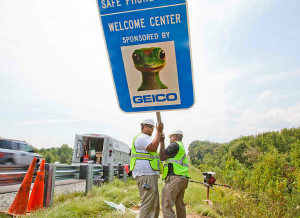

Insurance giant GEICO is going to become a lot more familiar to travelers who visit Virginia’s 43 Interstate rest stops, the Virginia Department of Transportation announced on Thursday.
The company has signed on to sponsor “safe phone zones” at the rest stops, part of an initiative by Gov. Bob McDonnell to defray the operating costs of the roadside stops.
The safe phone zones are areas where motorists can park and safely use their mobile phones for making calls as well as texting, surfing the Web and using other smartphone apps – activities that can result in a ticket if done while driving.
A Pennsylvania firm, CRH Catering Co., has been awarded the contract to provide vending services. The concessionaire has offices in Richmond and Norfolk and already manages vending and some advertising at Interstate highway rest stops in Pennsylvania, Maryland and West Virginia.
The three-year contract requires CRH combined with its new GEICO sponsorship partner to generate about $2 million a year in revenues for the Virginia Department of Transportation.
“As we all know, distracted driving is a major problem,” Joe Thomas, GEICO’s regional vice president, said in a news release. “We all want to let drivers know about the safe phone zones in Virginia, where people can take a break from driving at the state’s welcome centers.”

As part of the deal, GEICO will erect highway signs that direct people to the safe phone zones, another advertising vehicle for the company famed for a computer-generated talking gecko as its television pitch-lizard.
Making Virginia’s rest areas at least partially self-sustaining became an initiative for McDonnell, a Republican, shortly after he took office and reopened 19 rest stops that his predecessor, Democrat Tim Kaine, had shuttered as a cost-cutting move during a 2009 budget crisis.
Virginia rest areas serve an estimated 33 million visitors each year.